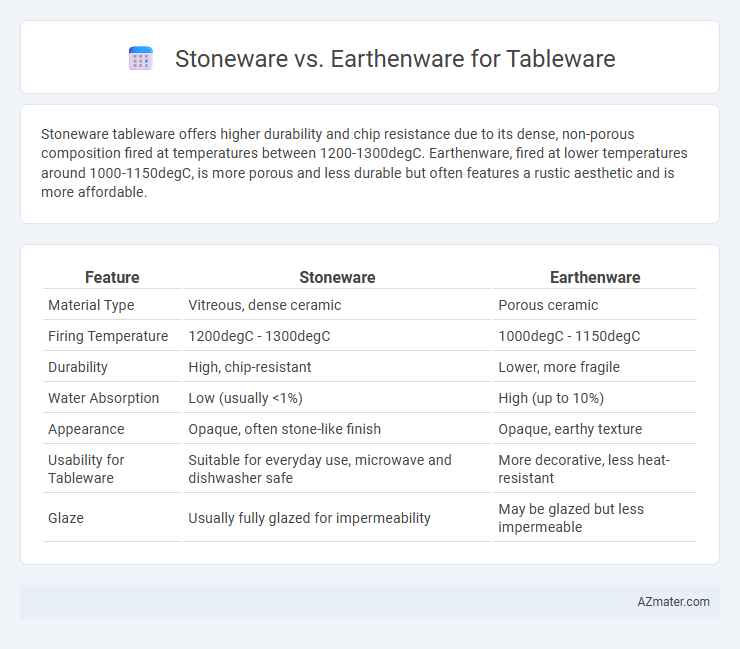Stoneware tableware offers higher durability and chip resistance due to its dense, non-porous composition fired at temperatures between 1200-1300degC. Earthenware, fired at lower temperatures around 1000-1150degC, is more porous and less durable but often features a rustic aesthetic and is more affordable.
Table of Comparison
| Feature | Stoneware | Earthenware |
|---|---|---|
| Material Type | Vitreous, dense ceramic | Porous ceramic |
| Firing Temperature | 1200degC - 1300degC | 1000degC - 1150degC |
| Durability | High, chip-resistant | Lower, more fragile |
| Water Absorption | Low (usually <1%) | High (up to 10%) |
| Appearance | Opaque, often stone-like finish | Opaque, earthy texture |
| Usability for Tableware | Suitable for everyday use, microwave and dishwasher safe | More decorative, less heat-resistant |
| Glaze | Usually fully glazed for impermeability | May be glazed but less impermeable |
Introduction to Stoneware and Earthenware
Stoneware and earthenware are two popular types of ceramic materials used for tableware, each with distinct properties and firing techniques. Stoneware is fired at higher temperatures, typically between 1,200degC and 1,300degC, resulting in a dense, durable, and non-porous finish ideal for everyday use and resistance to chipping. Earthenware, fired at lower temperatures around 1,000degC to 1,150degC, is more porous and softer, often glazed to enhance durability and used for decorative or casual dining pieces.
Key Differences Between Stoneware and Earthenware
Stoneware is denser and less porous than earthenware, making it more durable and chip-resistant, ideal for everyday Tableware. Earthenware is fired at lower temperatures and is more porous, often requiring a glaze to make it watertight and is typically lighter in weight with a rustic appearance. The key differences include firing temperature ranges (stoneware around 1,200-1,300degC, earthenware about 1,000-1,150degC), durability, and water absorption rates, impacting their suitability for different Tableware uses.
Material Composition and Manufacturing Process
Stoneware tableware is made from dense, non-porous clay fired at high temperatures between 1,200degC and 1,300degC, resulting in a durable and chip-resistant material. Earthenware consists of porous clay fired at lower temperatures around 1,000degC to 1,150degC, leading to a softer and more fragile texture that requires glazing for water resistance. The manufacturing process of stoneware involves vitrification, making it harder and less porous, while earthenware remains more porous and brittle due to incomplete vitrification.
Durability and Strength Comparison
Stoneware tableware offers superior durability and strength compared to earthenware, featuring a denser and less porous composition that resists chipping and cracking under daily use. Earthenware, while aesthetically pleasing and often more affordable, is more porous and brittle, making it susceptible to damage from thermal shock and heavy handling. For long-lasting, resilient tableware, stoneware is the preferred choice due to its enhanced structural integrity and resistance to wear.
Porosity and Water Absorption Rates
Stoneware exhibits lower porosity and water absorption rates, typically below 0.5%, making it more durable and less prone to staining compared to earthenware. Earthenware has higher porosity, absorbing up to 10% water, which can lead to increased susceptibility to chipping and moisture damage over time. These properties make stoneware the preferred choice for durable, non-porous tableware suitable for everyday use.
Heat Resistance and Oven Safety
Stoneware offers superior heat resistance compared to earthenware, making it ideal for oven use and high-temperature cooking. Earthenware is more porous and less durable under rapid temperature changes, which increases the risk of cracking or breaking in an oven. Choosing stoneware for tableware ensures better oven safety and longevity due to its dense, vitrified structure.
Aesthetic Qualities and Finished Appearance
Stoneware tableware features a dense, non-porous surface with a smooth matte or glossy finish, offering durability and a modern, rustic aesthetic that complements contemporary and farmhouse styles. Earthenware, characterized by its porous composition and vibrant glaze, presents a more traditional and handcrafted appearance with warm, earthy tones and often visible brushstrokes or textures. The finished appearance of stoneware typically exhibits uniformity and subtlety, while earthenware embraces imperfections, providing a charming, artisanal look.
Everyday Functionality and Maintenance
Stoneware offers superior durability and chip resistance compared to earthenware, making it ideal for everyday tableware that withstands frequent use and washing. Its non-porous surface requires less maintenance and resists stains and odors, unlike earthenware, which is more porous and prone to cracking or absorbing moisture. Stoneware's ability to tolerate microwave and dishwasher use enhances convenience, whereas earthenware often demands gentle handling and hand washing to preserve its finish.
Cost and Accessibility for Buyers
Stoneware tableware generally costs more than earthenware due to its durability and denser material, making it a preferred choice for long-term use despite a higher price point. Earthenware, being more porous and less durable, is often more affordable and accessible for buyers looking for budget-friendly or decorative options. Both types are widely available, but earthenware's lower cost typically makes it easier to find in a variety of styles at mass retailers.
Choosing the Right Tableware for Your Needs
Stoneware offers superior durability and chip resistance, making it ideal for everyday use and heavy handling, while earthenware provides a rustic aesthetic with a more porous texture suited for decorative or occasional use. Stoneware's higher firing temperature results in a denser, non-porous surface that resists staining and absorbs less moisture compared to earthenware, which is more prone to cracks and is less microwave safe. For consumers prioritizing longevity and practicality in tableware, stoneware is the preferred choice, whereas earthenware suits those seeking traditional craftsmanship and lighter usage.

Infographic: Stoneware vs Earthenware for Tableware
 azmater.com
azmater.com